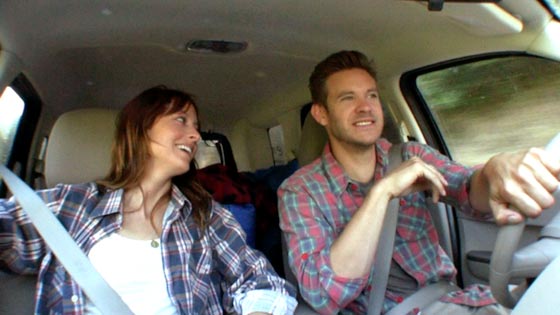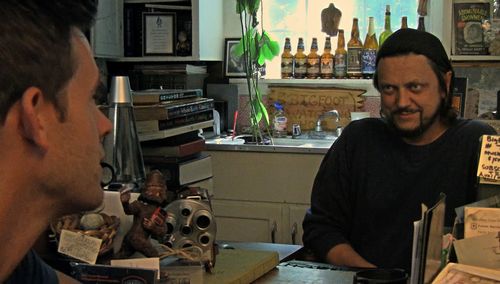Willow Creek | reviews, news & interviews
Willow Creek
Willow Creek
Bobcat Goldthwait finds Bigfoot, in effective, found-footage horror
The Bigfoot legend rests on something close to found-footage: 1967’s grainy film of a large ape-like creature loping through the remote American North-west. The Patterson-Gimlin expedition’s reels are the Sasquatch conspiracy theorists version of the Zapruder footage.
 We are entirely in the company of Jim (Bryce Johnson) and Kelly (Alexie Gilmore), pictured right. He’s a Bigfoot believer since childhood, on a birthday quest to film his trek to Willow Creek, and perhaps stumble on something to support his faith. Seeing Bigfoot is, unwisely, his greatest desire. She’s a happy-go-lucky, loving girlfriend supportively along for the trip, but sceptical about giant ape-men wandering even the 21st century USA’s least charted region undetected.
We are entirely in the company of Jim (Bryce Johnson) and Kelly (Alexie Gilmore), pictured right. He’s a Bigfoot believer since childhood, on a birthday quest to film his trek to Willow Creek, and perhaps stumble on something to support his faith. Seeing Bigfoot is, unwisely, his greatest desire. She’s a happy-go-lucky, loving girlfriend supportively along for the trip, but sceptical about giant ape-men wandering even the 21st century USA’s least charted region undetected.
Goldthwait uses the region to his advantage, training the camera on the Bigfoot statues, trinket shops and bars, and folk-art murals which suggest a secret culture of human-Sasquatch interdependence. History and mythology are indicated for this obscure and otherwise unresonant horror monster, but left unexplained. The eccentric locals Goldthwait left his actors to interview include “the Bob Dylan of Bigfoot songs” and the director himself (pictured below left). Initially known as a helium-voiced loose cannon in the Police Academy franchise, his turn as an unstable Bigfoot bookshop owner is a treat. Another local’s invitation to “have a nice slice of pie at the Fuck Off Café” typifies the pungent dialogue, and the idea of a protected, bad secret outsiders would be well-advised not to find.
 Willow Creek also works as an intimate autobiography of a relationship. Jim’s boyish, increasingly dense, stubborn pressing forward into the wilderness is initially indulged by Kelly. There’s a loose, freewheeling feel to their banter. They are a couple who find each other funny, making them necessarily attractive company, with the camera always on them. That camera, operated by the actors to make the footage appear authentically practical, only becomes an irritant as the expedition unravels, and isolation magnifies Jim’s faults. They remain loving, even under duress, making you feel and fear for them in Willow Creek’s second half, when the outside world falls away, and night descends on the forest.
Willow Creek also works as an intimate autobiography of a relationship. Jim’s boyish, increasingly dense, stubborn pressing forward into the wilderness is initially indulged by Kelly. There’s a loose, freewheeling feel to their banter. They are a couple who find each other funny, making them necessarily attractive company, with the camera always on them. That camera, operated by the actors to make the footage appear authentically practical, only becomes an irritant as the expedition unravels, and isolation magnifies Jim’s faults. They remain loving, even under duress, making you feel and fear for them in Willow Creek’s second half, when the outside world falls away, and night descends on the forest.
The film hinges on a 19-minute night-time take, inside a tent, far out on location. Jim and Kelly are woken by noises and movement outside. Their civilised veneers are scraped away gradually, until Kelly, a realist who fully grasps their helpless position, is consumed by fear. Goldthwait tried three takes, during one of which the actors were too freaked out to continue. This sometimes wandering, boring exercise in real-time fright shows what a self-financed two-hander can do, while revealing nothing except its makers’ expertise in human dread. As Jim thought all along, you don’t have to see Bigfoot to believe in him. He keeps the camera running anyway, for the bloodily brief selfie to end them all.
The future of Arts Journalism
You can stop theartsdesk.com closing!
We urgently need financing to survive. Our fundraising drive has thus far raised £49,000 but we need to reach £100,000 or we will be forced to close. Please contribute here: https://gofund.me/c3f6033d
And if you can forward this information to anyone who might assist, we’d be grateful.

Subscribe to theartsdesk.com
Thank you for continuing to read our work on theartsdesk.com. For unlimited access to every article in its entirety, including our archive of more than 15,000 pieces, we're asking for £5 per month or £40 per year. We feel it's a very good deal, and hope you do too.
To take a subscription now simply click here.
And if you're looking for that extra gift for a friend or family member, why not treat them to a theartsdesk.com gift subscription?
more Film
 The Other Way Around review - teasing Spanish study of a breakup with unexpected depth
Jonás Trueba's film holds the romcom up to the light for playful scrutiny
The Other Way Around review - teasing Spanish study of a breakup with unexpected depth
Jonás Trueba's film holds the romcom up to the light for playful scrutiny
 The Road to Patagonia review - journey to the end of the world
In search of love and the meaning of life on the boho surf trail
The Road to Patagonia review - journey to the end of the world
In search of love and the meaning of life on the boho surf trail
 theartsdesk Q&A: actor Emma Mackey on 'Hot Milk' and life education
The Anglo-French star of 'Sex Education' talks about her new film’s turbulent mother-daughter bind
theartsdesk Q&A: actor Emma Mackey on 'Hot Milk' and life education
The Anglo-French star of 'Sex Education' talks about her new film’s turbulent mother-daughter bind
 Blu-ray: A Hard Day's Night
The 'Citizen Kane' of jukebox musicals? Richard Lester's film captures Beatlemania in full flight
Blu-ray: A Hard Day's Night
The 'Citizen Kane' of jukebox musicals? Richard Lester's film captures Beatlemania in full flight
 Hot Milk review - a mother of a problem
Emma Mackey shines as a daughter drawn to the deep end of a family trauma
Hot Milk review - a mother of a problem
Emma Mackey shines as a daughter drawn to the deep end of a family trauma
 The Shrouds review - he wouldn't let it lie
More from the gruesome internal affairs department of David Cronenberg
The Shrouds review - he wouldn't let it lie
More from the gruesome internal affairs department of David Cronenberg
 Jurassic World Rebirth review - prehistoric franchise gets a new lease of life
Scarlett Johansson shines in roller-coaster dino-romp
Jurassic World Rebirth review - prehistoric franchise gets a new lease of life
Scarlett Johansson shines in roller-coaster dino-romp
 theartsdesk Q&A: director Andreas Dresen on his anti-Nazi resistance drama 'From Hilde, with Love'
The East German-born filmmaker explains why his biopic of the activist Hilde Coppi isn't bound to the 1940s
theartsdesk Q&A: director Andreas Dresen on his anti-Nazi resistance drama 'From Hilde, with Love'
The East German-born filmmaker explains why his biopic of the activist Hilde Coppi isn't bound to the 1940s
 Chicken Town review - sluggish rural comedy with few laughs (and one chicken)
A comedy great gets lost in an English backwater
Chicken Town review - sluggish rural comedy with few laughs (and one chicken)
A comedy great gets lost in an English backwater
 F1: The Movie review - Brad Pitt rolls back the years as maverick racer Sonny Hayes
Joseph Kosinski's motorsport spectacle delivers bang for your buck
F1: The Movie review - Brad Pitt rolls back the years as maverick racer Sonny Hayes
Joseph Kosinski's motorsport spectacle delivers bang for your buck
 Bleak landscapes and banjos: composer Bernard Hughes discusses his score for 'Chicken Town'
Our critic talks about his recent film project
Bleak landscapes and banjos: composer Bernard Hughes discusses his score for 'Chicken Town'
Our critic talks about his recent film project

Add comment